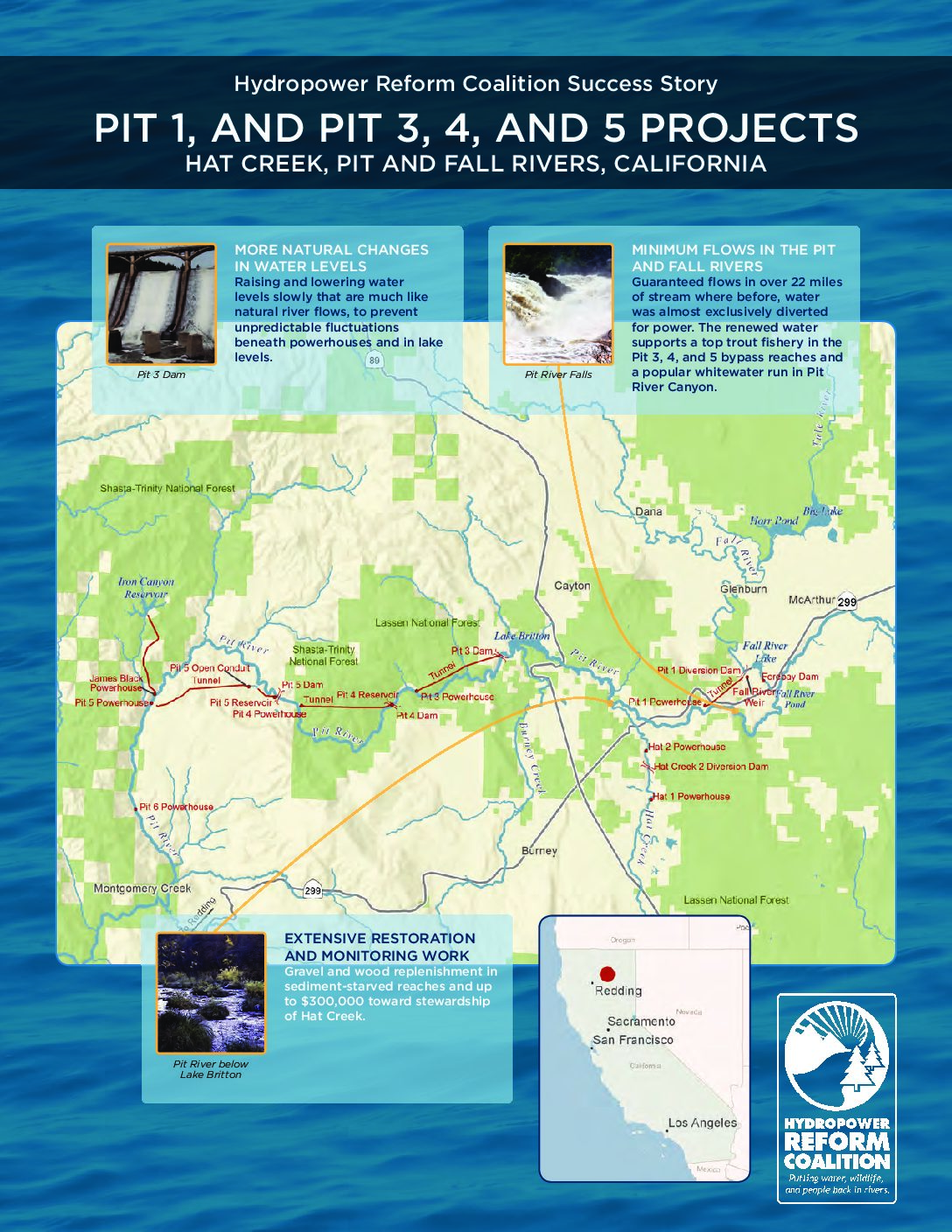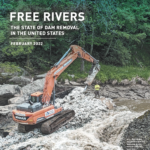The Pit River is the largest river in northeastern California; its watershed is 4,324 square miles. The mainstem Pit flows in a southwesterly direction through valleys and basalt canyons to Shasta Lake, where it eventually flows into the Sacramento River and San Francisco Bay.
The Pit River is heavily dammed for hydropower, and Pacific Gas & Electric (PG&E) holds several operating licenses in its system. The Pit projects are numbered by their age and upstream to downstream. The most upstream project, Pit 1, began construction in 1920. From 1923 to 1926, licenses were issued to construct Pit 3 and Pit 4 developments. In 1942, when PG&E renewed the license for Pit 3 and Pit 4, it also received authorization to construct Pit 5.
These dams, powerhouses, and diversions are captured under two operating licenses, “Pit 1” and “Pit 3, 4, and 5.” Each of these Pit developments involves at least one dam, a tunnel that carries diverted water out of the river, and a powerhouse – where power is generated and the water is returned to the Pit River. In the Pit 3, 4, and 5 developments, all of the tunnels are just over four miles long. This re-plumbing of the Pit River channels water around a combined 30 miles of natural riverbed.
By the time the Pit 1 operating license expired in 1995, PG&E had few environmental requirements. The Pit 1 forebay, only 12 to 15 feet deep, fluctuated as much as 3 feet per day in response to power demand. No minimum flows were required in any project reaches, leaving over 8 miles of the Fall and Pit Rivers dewatered and river levels downstream from the powerhouse highly unstable.
As required by the new Pit 1 license issued in 2003, PG&E releases steady water into the Pit River Canyon, fostering a popular Class III-IV whitewater run at the scenic Pit River Falls. New release rates for the powerhouse slowed unpredictable fluctuations and increased minimum flows. These new conditions helped to curb streamside erosion downstream and have created a robust trout fishery. In the diverted reach, punctuated flushing flows control unwanted vegetation from encroaching into the river channel and serve a dual benefit as a special whitewater release in the summer. For the previous eighty years, the project had operated with no flow requirements. Today, thanks to the new license, there is more balance.
When the Pit 3, 4, and 5 license was set to expire, PG&E adopted a new strategy: begin negotiations to create an agreement to settle principal issues. Convened in 1998, the Pit River Collaborative Team (PRCT) produced a settlement in 2003 that forms the framework of a new 2007 license. The license term – 36 years – is set to end at the same time as the Pit 1 license, for maximum coordination of the Pit River.
Several interests directed the licensing agreement. Bring water back into 22.5 miles of the Pit at slower naturalized rates. Enhance the top trout fishery in the Pit and in Hat Creek. Ensure that recreational resources – including fishing, whitewater, and the Pacific Crest Trail – were protected.
The PRCT agreement will result in new minimum releases that restore ecological flows to the Pit River. It also prescribed seasonal variation and a 0.5 foot-per-hour rate of change in releasing the flows, to mimic a natural hydrograph. The settlement agreed to provide recreational releases, but limited them to the Pit 5 bypass to balance all river interests. These renewed flows and key habitat enhancements such as gravel replenishment and transporting wood downstream from the reservoirs will improve instream conditions for fish and wildlife. To be sure that this work reaches its ecological targets, PG&E will monitor aquatic life and water quality extensively over the life of the license, guiding adaptive management decisions for the river.
Through the settlement talks, key parties also resolved protection of the Hat Creek Wild Trout Management Area. Established in 1969, the Area is the first state-designated Wild Trout Creek. At the base of its 3.5 mile length, the state constructed a barrier dam to prevent the warmwater fishery of Lake Britton from invading the prized coldwater trout fishery [pictured at right]. A separate 2003 agreement, partially incorporated into the license, commits PG&E to funding 50% of the costs to maintain the barrier dam, and to providing $300,000 toward stewardship management over the next 30 years.


 HRC or member-contributed
HRC or member-contributed